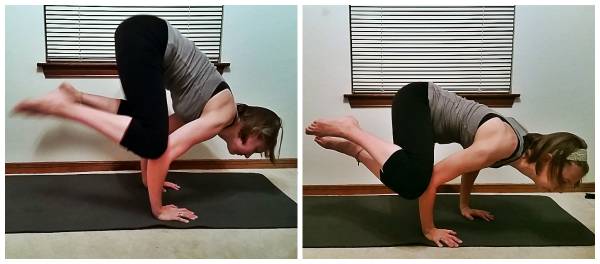Most of us are afraid of something. For me, it’s being upside down. I barely passed swim class in high school because I was scared of diving headfirst. Even in a simple yoga pose like downward dog, I dislike the feeling of pressure in my head.
For a long time I was one of those people who avoided handstands in yoga and CrossFit. So when I read the words “Arm Balances” on the syllabus for my yoga teacher training weekend, I was not excited.
Mayurasana, Peacock Pose. I wish this was me, but it is not. I’m working on it.
What Are Arm Balances?
Fortunately for me, not all arm-supported yoga poses are inversions. Here are a few examples of yoga arm supported poses and arm balances that don’t involve being totally upside down:
Arm Supported Poses:
- Upward-Facing Dog
- Four-Limbed Stick Pose
- Upward Bow Pose
- Side Plank Pose
- Four-Footed Table Top Pose
- Upward Plank Pose

These poses are more my speed. That’s me doing Four-Footed Table Top (left), and Four-Limbed Stick Pose (right)
Arm Balances:
- Crow Pose
- Side Crow Pose
- Eight-Angle Pose
- Mayurasana

That’s me getting the hang of being (almost) upside down. Left: Crow; Right: Side Crow.
I need to work on getting my knees up higher on my arms.
Anatomy of Arm Support
I realized while reading about arm balances that maybe my fear of handstands isn’t just about being upside down, but also about not feeling confident on my hands. From an anatomical perspective, balancing on your hands is an impressive and difficult feat. In his book, Yoga Anatomy, anatomy expert Leslie Kaminoff provides a fascinating explanation of how arm balances differ from our usual habit of balancing on our feet:
In the foot, the heavy, dense tarsal bones comprise half the length of its structure. Adding to this the weight-bearing function of the metatarsals, it can be said that four fifths of the foot’s structure is dedicated to weight bearing…
These proportions are completely reversed in the hand, where half the length of the structure is composed of the highly mobile phalangeal (finger) bones. The hand’s metacarpals are also very mobile (compared to the metatarsals), whereas the relatively immobile carpals (wrist bones) comprise only one fifth of the hand. This means that even if you effectively recruit the metacarpals in arm support, you still have only half the length of the hand structured for weight bearing.
When you use the upper limbs in weight-bearing poses, you have to take into account the fact that they are at a structural disadvantage and take extra care in preparation and execution.
Preparation
The most important thing I learned during my training weekend was how to properly prepare for arm balances. My teacher, Libby Cox, did an excellent job of warming us up before attempting forearmstands and handstands.
These three tips she shared will be helpful for anyone doing arm balances and inversions in their yoga practices or workouts:
- Prepare the hands, wrists, and shoulders. These areas will bear most of the burden during arm balances and inversions. Warm up the wrists by rolling them out and practice simple poses that use the hands as a base, like plank. You can also practice keeping your arms strong and active while lying on your back in a reclined crow pose.
- Warm up the core. In addition to working the rectus abdominis and transverse abdominis, Libby frequently cued us to lengthen through the obliques and squeeze the inner thighs together to fire the core and create stability in the back muscles.
- Don’t forget the legs. I had never considered how much of a part the legs play in inversions. Libby pointed out the need for warming up the hamstrings with forward bends. In yoga, when you move into many of the arm balances, you move through a standing forward bend. The legs also need to be engaged once you are in the poses, not just hanging out in space.
Shift Your Perspective On Inversions
Since our training, my perspective on inversions and my so-called fear of them has changed. I decided to focus on mastering arm balances before I start with inversions. It’s only been a few weeks, but just by getting used to the feeling of balancing on my hands, I feel more confident when I experiment with inversions.
As Ray Long writes in his book, Yoga Mat Companion 4: Anatomy for Arm Balances and Inversions:
Central to any story is a conflict that must be reconciled or an obstacle that must be overcome. Tension builds, and a crescendo is reached, followed by denouement. A solution must be negotiated. In the best stories, this dynamic evokes a cognitive shift in the audience, a new perspective. Consider this in the context of a pose or practice session. Use the metaphor of narrative structure to deepen the transformative power of yoga.
What is the conflict you face in your training or yoga practice? If, like me, you have apprehension about inversions, try practicing arm-supported poses first.
Or if you’re already confident upside down, use arm balances as a warm up to bring you to the next level. You might be surprised at how your perspective on your own strength and stability changes.
You’ll Also Enjoy:
- Dear Willow: Any Tips on Crow Pose?
- Arm Balancing: Improve Your Strength Through Alignment
- How to Set Fear Aside and Move Forward – In a Yoga Pose and In Life
- What’s New On Breaking Muscle Today
Photo 1 courtesy of Shutterstock.






